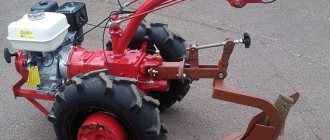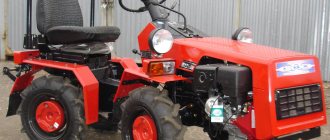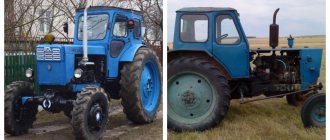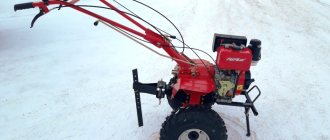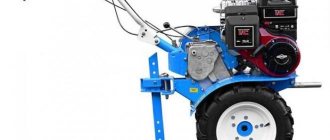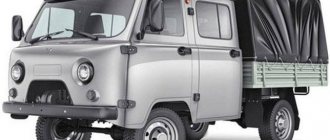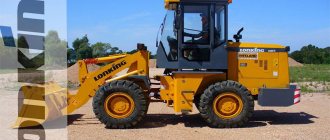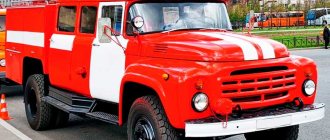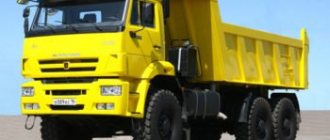Tuning the MTZ 09n walk-behind tractor
First operating experience - 2012
The joy of the purchase diminished as soon as I started using the walk-behind tractor on my garden plot in the spring. There were many questions about the walk-behind tractor and the attached units. Some issues were resolved immediately, some by correcting agricultural technology, and some by creative modification of the walk-behind tractor and its units. Thus, the walk-behind tractor really turned out to be a design kit for me for serious creative development and technical improvement. As a result of the work done, I received a walk-behind tractor, on which I work with pleasure, without much stress, and I am always satisfied with the result of my work. But first things first.
Bottom slide
When you work with a plow or hiller and turn around at the end of the furrow, you have to keep the walk-behind tractor balanced so that it does not catch the ground with the working part and does not bury itself in the ground with the subframe of the footrest. This is very inconvenient, especially when moving across furrows. This small drawback was easily eliminated: I welded two skis made of metal plates measuring 3mm x 70mm x 300mm to the footrest subframe, with a 40mm slope at the front and rear. I welded it like this: I installed the walk-behind tractor on a flat, hard surface (on a concrete path), placed two made skis under the footrest subframe and welded it in place with the addition of reinforcing elements.
The photo shows that a transverse rod with a pin is welded to the front of the ski and the subframe of the footrest. The pin serves to hang the counterweight load in some cases, and the crossbar serves as a bumper, protecting the front grille of the engine cooling fan from damage.
After installing the lower slides I received:
— the walk-behind tractor, even with the engine running, can be safely tilted forward and lowered onto the sled without fear of consequences;
— the walk-behind tractor can be driven forward or in reverse on any surface, even plowing, by raising the control handles all the way up and lowering them onto the sled. The walk-behind tractor moves steadily, does not get buried and is not damaged.
Control rod
The control handles (in the technical description are designated as steering rod levers) in the Belarus-09N walk-behind tractor are the same as in other walk-behind tractors. And, I must say, very uncomfortable. Therefore, everything had to be fundamentally changed. After several trial options, I made and installed a moving control rod.
The control rod allows you to:
— confidently drive a walk-behind tractor. These are not some sticking out two handles. When you grab the control bar, you feel complete control over the walk-behind tractor;
— during plowing, when the wheels fall on fresh manure or in a deep transverse furrow, it becomes necessary to push the walk-behind tractor a little. In this case, this is easy to do by pushing your body into the control rod;
— while driving with a semi-trailer, during sharp braking or when descending a steep hill, the control bar serves as a reliable hand rest, preventing the driver from slipping from the seat onto the walk-behind tractor.
The ability to move the control rod additionally provides:
— more space for hanging any units. In this case, the control rod moves to the required distance;
— when plowing and harrowing, I move the control bar as far back as possible. In this case, the load on the hands is reduced by 1.4 times and the work is made so much easier that your back is not wet and work is a pleasure.
The design of the moving control rod is visible in the picture.
I shortened the standard control handles to a length of 420mm. I welded two ¾-inch guide tubes, 90 mm long, to them using plates. The rod holders are two ½ inch pipes 630mm long, one end of which is flattened and a hole with a diameter of 8mm is drilled in it. Along the entire length of the rod holders, I drilled through holes in 100mm increments for fixing with bolts in the guide bushings. The rod itself is a ½-inch pipe 530 mm long, in which two plugs with an M8 thread cut along the axis for fastening to the holders are inserted at the ends and secured with welding rivets. I installed two homemade control levers on the rod, and put two rubber pads on the edges that stood on the standard control handles. The control rod can rotate around its axis within 90 0 on the mounting bolts. This angle of rotation is determined by the welded stop. This makes it possible to raise and lower the control bar when plowing without twisting your arms. In other words: it is not the hands that turn under the control levers, but the control levers that turn under the hands. To appreciate the beauty of this modification, try lifting the steering rod levers up on an unmodified walk-behind tractor and, in this position, squeeze the clutch lever. This is very difficult to do. And when plowing, this must be done constantly on turns.
Control levers
The operation of the walk-behind tractor has shown that the differential lock function is a very necessary thing and needs to be used quite often:
- when plowing on an uneven, potholed area;
— when plowing an area fertilized with fresh manure, or plowing fallow;
— when moving across furrows; — when harrowing with a large harrow;
— when transporting a loaded semi-trailer over rough terrain;
— when working with a bulldozer blade, etc.
In all these cases, the differential lock must be either occasionally turned on or turned off occasionally. Using the standard differential lock handle installed on the steering bar remote control is extremely inconvenient: you have to stop every time, reach for it and pull it towards you or push it away from you, look for the moment of its operation by turning the walk-behind tractor. Therefore, I brought the differential lock control to the control rod, where I installed the differential lock release lever under my right hand. I installed the clutch release lever under my left hand on the control rod.
Specifications
The weight of the Belarus 09N walk-behind tractor is 176 kg. The nominal traction force of the equipment is 0.8 kN, the maximum transport speed is 12 km/h, the operating speed is 2.6 km/h. The model can be used with a trailer weighing up to 650 kg.
Overall dimensions of equipment:
- length – 1780 mm;
- width – 846 mm;
- height – 1070 mm;
- minimum turning radius – 1000 mm;
- ground clearance - 295 mm.
The track of the Belarus 09N model is adjustable from 450 mm to 700 mm. The model belongs to the category of vehicles of the 0.1 traction class.
Fuel consumption
The fuel tank of the walk-behind tractor holds 6 liters of fuel. The specific fuel consumption for this model is 319 g/kW per hour.
Tuning the MTZ 09n walk-behind tractor
Improvements to the walk-behind tractor 2018.
Since I love to be creative and cannot sit idle, I continued to refine and improve the components and systems of the Belarus-09N walk-behind tractor.
1. Made weights (weights) for the wheels of the walk-behind tractor with increased weight.
When performing heavy work (plowing over scattered manure, plowing while moving uphill, transporting a loaded trailer over rough terrain, working with a blade, clearing snow with a blade, towing a trailer in winter, etc.), there was a lack of traction between the walk-behind tractor wheels and the ground due to the small weight. Therefore, instead of standard factory weights of 2 x 16 kg, I installed weights of 2 x 20 kg cut from a slab 30 mm thick, with a diameter of 340 mm. Having a thickness of 30 mm, the loads are hidden inside the wheel rim and do not protrude beyond the dimensions of the wheel. In addition, if necessary, I install additional weights with a diameter of 430 mm, cut from a 30 mm plate, weighing 2 x 30 kg. Thus, I increase the weight of the walk-behind tractor by 100 kg. The slippage stopped, the range of work expanded.
2. Replaced the GX270 engine, 9 hp, weighing 25 kg with the GX420E engine, 16 hp, weighing 36 kg.
After installing wheels with a diameter of F-122 with a diameter of 704 mm with an all-terrain tread (initially, the plant installed tires measuring 5.9x13 inches on MTZ-06 walk-behind tractors, and these are Luazovsky tires IV-167 with a height of 749 mm), the above loads with a total weight of 100 kg and with the corresponding the workload began to lack engine power. After some thought, the GX270 engine was replaced with a GX420E. The engines are identical in fit and mounting dimensions. I moved the hub with the clutch cup from the GX270 to the GX420E and installed it on the walk-behind tractor. Operation has shown: the engine operates at medium and below average speeds, there is enough power and traction to perform any work and all my whims, there are no complaints about the walk-behind tractor in this regard.
So, like the GX420E engine with an electric starter, I welded the corresponding frame and installed a car battery with a capacity of 55 Ah, weighing 12 kg, behind the engine. The battery is old, it worked for 10 years on a Ford car, but the remaining capacity is enough to service the walk-behind tractor.
4. I made a glove compartment and installed it above the battery.
The glove box was cut and bent from 0.5 mm galvanized sheet metal. It is not attached in any way, but is simply inserted tightly into the welded frame for the battery. To prevent the glove compartment from shorting the battery terminals, a plastic plate is placed under it. The glove compartment is closed with a decorative lid made of galvanized sheet. The same cover closes the outputs of the gearshift shafts from the penetration of moisture into the gearbox during rain. The result is a convenient place to store everything that may be needed for prompt maintenance of the walk-behind tractor and trailed units.
5. Made a remote control panel.
I made and installed a control panel on one of the steering outriggers within reach of my hand. It is equipped with: 1 – engine stop toggle switch – to stop the engine and block its start; 2 – toggle switch for turning on the headlight – to control the operation of the headlight and side lights after their installation; 3 – engine start button – for remote engine start using an electric starter; 4 – choke control handle – for starting a cold engine at the first start or after a long stop.
All these improvements can be viewed on Youtube if you enter the query “MTZ 09 improvements 2018” in the search bar.
Source
Design of the MTZ 9N walk-behind tractor
The HONDA
GX series engine model 270 (manufactured in Japan) is red, the tank is white, it has a power of 9 liters. With.
GX Series
- engines intended for general use, designed for continuous operation in harsh conditions for a long time. It is in demand in the production of construction and garden equipment, various industrial equipment, and is used for power plants. This series includes gasoline carburetor engines (“G” - gasoline), the cylinder has an inclined position (“X”), the shaft is located horizontally, if there is no letter “V”, then it is vertical.
Model 270
— GCAB class equipment: 4-pin carburetor single-cylinder (volume 270 cm3, piston diameter – 77 mm, piston stroke – 58 mm) gasoline engine. It has forced air cooling, the cylinder valves are located at the top (OHV - overheard-valve), the horizontal and gas distribution shaft are located at the bottom, the cylinder is placed at an angle of 25o. The production involves the latest achievements of technical progress in the development of multi-purpose engines.
Design features guarantee:
Long service life - thanks to components designed to last (rigid crankcase, forged steel crankshaft, cast iron cylinder liner).
Economical - with maximum performance, fuel consumption is minimal. Thanks to the digital CDI ignition system with adjustable spark timing, a carefully designed camshaft guarantees precise control of valve timing and optimal valve overlap for improved fuel efficiency. Precisely tuned valve opening ensures maximum power from fuel consumed, as well as maximum compression ratio and valve placement at the top.
Efficiency - maximum power in its class based on cylinder volume.
Increased reliability - high quality materials are used, the carburetor has a galvanic coating that protects from fuel impurities, double air purification, and an oil level sensor.
Minimal vibration - thanks to the detailed design of components, ball bearings supporting the crankshaft, improved piston design, balanced heavy shaft.
Minimum noise level - during operation they make significantly less noise than previous models and analogues due to the huge volume multi-chamber exhaust system, an improved air intake system, an updated muffler and shaft, and a special piston design).
Environmental friendliness - low-toxic exhausts that meet modern global emission standards (EPA and CARB certificates of conformity, emissions are reduced without loss of power).
Easier starting - due to special HONDA technology, transistor-magnetic ignition system, decompression system, engine starting is made easier, cord resistance at the moment of starting is reduced.
Easy operation and maintenance - easy-to-operate throttle, large fuel tank with ergonomic automotive-style cap, easy access to air filter and spark plug.
Starting system - electric starter / manual starter (optional). The weight of the “dry” engine is 25 kg. For its operation, it is recommended to use unleaded gasoline AI-92 (TU 38.001165-97), oil SAE 10W-40, 10W-30.
Fuel tank, volume - 5.30 l., oil volume - 1.10 l., gearbox oil bath - 3.50 l.
At rated power output, fuel consumption is 230 g/l. With. in 1 hour (313 g/kWh) or 2.50 liters in 1 hour at 3600 rpm.
Walk-behind tractor transmission
- this is a power mechanism that transmits torque to the wheels from the engine, as well as to the power take-off shaft (PTO). The structure includes a clutch, gearbox, main gear with differential, final drive, PTO bushing. The main gear and gearbox are located in the same housing. Which also has a PTO coupling and final drive. The transmission design is all-wheel drive (2*2) with differential.
Clutch
- disc, friction. This is a multi-plate, permanently closed, manually operated, oil-immersed clutch whose engagement briefly disconnects the engine from the transmission. The clutch design consists of a disk, a spring and two drums. A drive drum is installed at the output end of the engine crankshaft. A driven drum is installed on the input shaft of the gearbox. The clutch is controlled mechanically using a control lever.
Transmission
— gear, oil-filled, mechanical, in a closed housing. It consists of a primary, intermediate and secondary shaft mounted in parallel on bearings. Used to change the speed of movement of the walk-behind tractor, provides reverse due to the control and gear shift mechanism.
The gearbox control mechanism is used to engage reverse and forward gears and change gears. The reverse control mechanism guarantees 2 operating modes: reverse and forward. The gear shift mechanism consists of 4 forward and 2 reverse gears. If the arc is installed in reverse - 2 gears backward, 2 - forward.
Main gear with differential
– increases torque, direction of rotation changes. Includes a drive gear integral with the transmission output shaft and a driven gear attached to the differential housing. Which guarantees the rotation of the wheels at different angular speeds, which is in demand when turning the walk-behind tractor, also when moving on an uneven surface. The differential, through the gears of the axle shafts (left and right), transmits torque to the final drive gear shafts.
Final drives
increase torque and transmission of rotation to the wheels. These are single-stage gearboxes with spur gears. The pinion shaft in each gearbox, due to the drive gear and the final drive gear, imparts rotation to the flange shaft on which the wheel is mounted.
Tuning the MTZ 09n walk-behind tractor
Improvements to the walk-behind tractor. Continuation.
In order to drive the differential lock using a cable, it is necessary to weld an eye to the steering rod. The thrust screw of the cable casing is screwed into this eye to adjust the tension and the thrust spring for locking is supported.
The gear shift system along with the reverse activation system has also undergone modifications. In the standard version, these systems have large backlashes and there is no clear gear engagement; you have to catch them, which is very inconvenient.
The first thing I did was connect the rods to the corresponding levers on the gearbox directly, directly.
I lengthened the reverse lever and gear shift lever, located on the remote control of the steering rod, twice, by welding 4x20x100 tires. I put standard rubber knobs on the ends of the levers.
MTZ models
Many owners of walk-behind tractors simplify their lives and turn it into a mini tractor. To do this, you just need to carry it out.
All MTZ walk-behind tractors are quite large and powerful. Therefore, they can be used as a base for conversion into a tractor. Even the old version 5 is suitable for these purposes. It was made back in the Soviet Union, where the emphasis was on quality.
Based on the design, it is easiest to remake the MTZ-09N or MTZ-12.
All diagrams and drawings must be strictly followed. Because otherwise your mini tractor will not work properly.
These are the most powerful and heaviest representatives of the Belarusian family. But it is model 9 that is more popular, so it is this one that is most often remade.
If with other walk-behind tractors it is possible to make a 3-wheeled all-terrain vehicle, then with MTZ this will not work. It is equipped with a two-cylinder diesel engine. Therefore, it is recommended to use only 4 wheel options.
Walk-behind tractor cost
If you plan to purchase this kind of device, especially with a Japanese engine, it should be noted that they are sold only by official dealers, and the plant itself does not sell products to retail customers.
Prices for the device may vary and depend on the type of motor installed and the seller’s pricing policy. The average cost of new products ranges from 67.2 to 80.4 thousand rubles. A used option will cost much less - about 37 thousand rubles. At the same time, there are quite a few offers for the sale of used models, which indicates the high quality of the products.
Details
The mini tractor from the MTZ-05 walk-behind tractor is based on several parts. Let's look at each of them.
Frame and body
These two elements are basic for the entire tractor. Everything else will rest on them. Therefore, for the manufacture of the frame it is best to use strong new metal that has not yet been used.
The ideal material for the frame would be iron channel No. 5, or even better, No. 9. And for the body, high-quality steel with a thickness of 3 mm or more is suitable. Do not be afraid of heavy weight, MTZ-05 is designed to work with such loads.
Seat and steering
You can take any car seat and install it behind the engine on a prepared frame.
The steering system will also have to be modernized. To do this, you will need to use an old steering wheel from a car or motorcycle. As practice shows, a motorcycle steering wheel is more convenient to use.
Wheels and tires
This is a special part, since the speed of the mini tractor and its grip on the ground will depend on the quality of the tires. Therefore, it is not recommended to use old, “bald” tires.
Wheels must have high-quality treads to move on any surface.
Installation of levers
The control of the walk-behind tractor also needs to be transferred. Since in the usual form everything was controlled using steering levers, now this will need to be modernized.
Changing control levers:
- Move the gas and brake under the pedals of the mini tractor.
- Change gears in the classic way using a lever.
- Move the ignition button.
Agricultural assistant Belarus 09N: use of a walk-behind tractor
The Belarus 09N walk-behind tractor is produced at the Smorgon Aggregate Plant, which is part of the MTZ holding (Minsk Tractor Plant).
This enterprise was built in 1982 to produce components for MTZ Belarus tractors.
As it developed, the plant mastered the production of new products and the range of manufactured products is varied:
- mini tractors;
- garden tractors;
- agricultural trailed and mining (ploughs, harrows, cultivators, mowers, cutters);
- motor cultivators;
- special equipment;
- walk-behind tractors;
- 920 series tractors;
- components and spare parts for special equipment, mounted and trailed equipment, tractors, including for the MTZ 3022 and MTZ 622 models;
- municipal equipment based on MTZ;
- mounted and trailed equipment for MTZ walk-behind tractors (harrows, plows, seeders, cultivators, potato diggers).
Schemes and drawings
There are a large number of diagrams on the forums on how to assemble a mini tractor from Belarus.
First of all, it is necessary to understand what kind of kinematic chain all parts of the future machine have.
Planning is an important part, so it is better to make a mini tractor according to the drawings, and not by eye. In this case, everything will fit exactly and work stably.
The following diagram shows the location of all levers and switches; this must be thought out in advance. This option is taken from the Ant minitractor, and most of such equipment is made in this design.
Analogs
Analogs of the Belarus 09N walk-behind tractor include the Chinese Grasshopper 9 hp, the cost of which is several times less than its Belarusian competitor. Also analogues of the model are the Zubr (8 hp), Neva and Centaur MB 2075D vehicles.
SIMILAR ARTICLESMORE FROM THE AUTHOR
Hand cultivator Tornado
Motoblock Pubert
Motoblock Forza
2 COMMENTS
I bought a Cascade MB, which I have been using since 1990, to replace it, so I have something to compare it with. The advantages of heavy MB are obvious and undeniable. The Honda engine is simply a miracle, no complaints after 3 years of hard work, the power transmission and chassis are worked out and work fine, with the exception of minor shortcomings, namely: unclear engagement of 1st and 3rd gears and if 1st gear is practically is not needed (sometimes I use an active cutter when cultivating the soil), then the 3rd is the main one for plowing and it takes a long time to find the 1st and 3rd gears. There are more serious shortcomings in the controls and attachments, namely: 1.- the “stop” button fell apart in a week, I turn off the engine by touching the ground with the wire, which is extremely inconvenient; -the travel of the “clutch” lever is not enough to disengage it completely; with maximum adjustment, the clutch either “drives” or slips, which is not great. I cut the rubber on the end of the handle, it became better, but, you see, this is not the level! – the force from the handles to the pipe is transmitted through a box made of thin metal, which was cracked across the entire width – it was necessary to weld reinforcement from an 8 mm square; – the same thin metal has worn through at the engagement point of the differential tooth, which leads to its spontaneous engagement, and this is already dangerous in transport mode (it is completely unexpectedly impossible to turn). 2.- The plow is not thought out at all, apparently “licked” from a tractor. I didn't like the screw adjustment. The MB must move in a straight line, breaking the center line of the MB - the plow (which is supposed to be according to the instructions) forces the MB to crawl out of the furrow, or to climb into plowing. Look at how the plowing width is adjusted on horse plows - the ring in the comb is thrown over, thereby the plow moves to the right (left), changing the plowing width. Next, the plowman holds the plow vertically, on the MB it is rigidly connected to the body with a fairly long lever, when the MB body swings, the plow wobbles noticeably, the furrow is uneven and if it is not corrected during the next pass, a “belly” grows, since the MB wheel repeats the bend of the previous pass . Back in the 90s I saw the work of a “foreign” walk-behind tractor - there the plow share was located horizontally, the blade was thrown to either side, all the adjustments were thought out to the smallest detail. Friends, maybe you shouldn’t invent something that has already been invented and works great! Sincerely.
Assembly steps
- It is necessary to connect the chassis with wheels to the frame and install the engine. It is recommended to install front-wheel drive. In this case, the walk-behind tractor will have greater maneuverability, and when driving uphill there will be less chance of slipping, since the grip on the ground will be better.
- After installing the drive, a steel plate is welded to the rear surface of the frame, on which the seat and steering wheel will be installed. Then the steering wheel is connected to the chassis to control the MTZ mini tractor.
- The next step is to remove all control levers for the mini tractor. They must be in accordance with the kinematic diagram presented earlier.
An important nuance is the gas tank; for safety reasons, it must be covered to prevent accidental fire. Therefore, it is recommended to completely enclose the entire engine, along with the gas tank, with a homemade casing.
- It is necessary to further consider the location of the battery and headlights in the mini tractor. Thanks to the battery, you can install a car ignition; it is more reliable in winter, when it gets cold outside and the Belarusian engine does not start the first time.
- Headlights are connected to the generator; they will allow you to work in the evening.
- It is also recommended to protect the wheels with mud flaps, since when driving through mud at speed, it will fly abundantly in different directions.
- The point of operation of a mini tractor is in the attachments, so you should carefully consider the moment with its connection. To do this, the power take-off shaft must be extended and located behind the machine.
All-terrain attachment
Crawler attachments allow you to build a real all-terrain vehicle from an ordinary walk-behind tractor! To do this, there is no need to rebuild anything in the walk-behind tractor itself, or its individual components. Simply remove the regular wheels and install all-terrain tracks in their place.
In our winter conditions, this is simply an irreplaceable assistant; the all-terrain vehicle can be used for driving on snow, for this you can connect an adapter, but not the usual one in the form of a seat and wheels, but in the form of skis.
The track attachment can also be used after rainfall. Ordinary wheels are not designed for driving on wet soil, because even the lugs slip. The tracked all-terrain module allows you to significantly increase the traction capabilities and drive on any surface.
Video review of the MTZ-09N walk-behind tractor on skis
The Russian one offers its all-terrain tracked attachments for MTZ walk-behind tractors. They are designed to work together, because despite the heavy weight, the Krutets console can withstand it.
Features of the Krutets tracked attachment:
- compatible not only with MTZ, but also with other walk-behind tractors. Due to their design, they are ideally suited for the “drilling” of each of them.
- The length of the all-terrain attachment is 140 cm, height – 29 cm, width – 54 cm.
- The weight of the structure is 71 kg.
- The power of the walk-behind tractor allows you to move this equipment without problems.
Remember that you can’t make mistakes off-road! And you should be attentive and careful when driving an all-terrain vehicle.
Engine
Belarus 09N is equipped with various gasoline power plants running on AI-92 (AI-95). All of them are adapted for continuous long-term work under intense conditions. For this purpose, a cast iron cylinder liner is used in the design of the motors.
The most widely used models are those with the 4-stroke 1-cylinder Japanese unit Honda GX270. For work performed using a walk-behind tractor, this engine is quite sufficient.
Power plant characteristics:
- working volume – 0.27 l;
- rated power – 6.6 (9) kW (hp);
- rotation speed – 3600 rpm.
The Japanese Honda GX270 engine is distinguished by its high reliability and structural strength.
Belarus 09N is also equipped with Chinese units Lifan LF177 and Kipor KG280. These power plants have similar power characteristics, but are less expensive.
With new engines that replaced the UD-15 and UD-25 engines, the walk-behind tractor has become more economical and complex. The new power plants had a good start.
Reviews
It is not possible to convert the MTZ-05 walk-behind tractor into a mini tractor without help. Therefore, be sure to take a look at the forums where designers share tips on how to do this:
“The urge to do something must be in the blood, otherwise it will be financially costly. I can’t pass by any piece of iron, but I always mentally scroll through where it can be attached, this is how design ideas are created. Carefully inspect everything you have, lay it out, figure out what can be made from it, what you would like to see in the end, what else needs to be found, if you can’t imagine it right away, then look at the forums for approximate drawings, and then the picture will become more clear"
“Greetings to everyone reading from the designer of tractor equipment. I would like to give you one piece of practical advice: start making a mini tractor only if you are confident in your abilities and have a lot of time, money and patience. If there is even a drop of doubt, then it’s better not to start! Make a cart or adapter with a seat. And don't bother with 4x4 drive. This is difficult to implement. Equip your Belarusian with an adapter and 7.5x16 tires. And you will run faster, and there will be more traction"
Source
